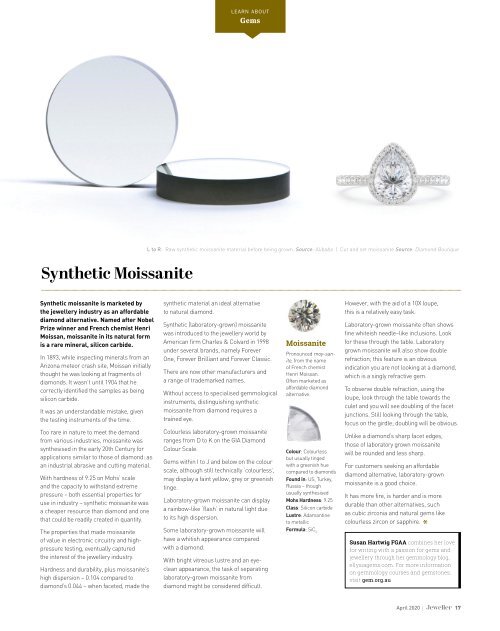Jeweller - April 2020
• Conquering Coronavirus: protect and prepare your business during the pandemic • Time frame: exploring five years of change in the watch category • Watch this space: a showcase of best-selling and new release watches
• Conquering Coronavirus: protect and prepare your business during the pandemic
• Time frame: exploring five years of change in the watch category
• Watch this space: a showcase of best-selling and new release watches
You also want an ePaper? Increase the reach of your titles
YUMPU automatically turns print PDFs into web optimized ePapers that Google loves.
LEARN ABOUT<br />
Gems<br />
Synthetic Moissanite<br />
L to R: Raw synthetic moissanite material before being grown. Source: Alibaba | Cut and set moissanite Source: Diamond Boutique<br />
Synthetic moissanite is marketed by<br />
the jewellery industry as an affordable<br />
diamond alternative. Named after Nobel<br />
Prize winner and French chemist Henri<br />
Moissan, moissanite in its natural form<br />
is a rare mineral, silicon carbide.<br />
In 1893, while inspecting minerals from an<br />
Arizona meteor crash site, Moissan initially<br />
thought he was looking at fragments of<br />
diamonds. It wasn’t until 1904 that he<br />
correctly identified the samples as being<br />
silicon carbide.<br />
It was an understandable mistake, given<br />
the testing instruments of the time.<br />
Too rare in nature to meet the demand<br />
from various industries, moissanite was<br />
synthesised in the early 20th Century for<br />
applications similar to those of diamond: as<br />
an industrial abrasive and cutting material.<br />
With hardness of 9.25 on Mohs’ scale<br />
and the capacity to withstand extreme<br />
pressure – both essential properties for<br />
use in industry – synthetic moissanite was<br />
a cheaper resource than diamond and one<br />
that could be readily created in quantity.<br />
The properties that made moissanite<br />
of value in electronic circuitry and highpressure<br />
testing, eventually captured<br />
the interest of the jewellery industry.<br />
Hardness and durability, plus moissanite’s<br />
high dispersion – 0.104 compared to<br />
diamond’s 0.044 – when faceted, made the<br />
synthetic material an ideal alternative<br />
to natural diamond.<br />
Synthetic (laboratory-grown) moissanite<br />
was introduced to the jewellery world by<br />
American firm Charles & Colvard in 1998<br />
under several brands, namely Forever<br />
One, Forever Brilliant and Forever Classic.<br />
There are now other manufacturers and<br />
a range of trademarked names.<br />
Without access to specialised gemmological<br />
instruments, distinguishing synthetic<br />
moissanite from diamond requires a<br />
trained eye.<br />
Colourless laboratory-grown moissanite<br />
ranges from D to K on the GIA Diamond<br />
Colour Scale.<br />
Gems within I to J and below on the colour<br />
scale, although still technically ‘colourless’,<br />
may display a faint yellow, grey or greenish<br />
tinge.<br />
Laboratory-grown moissanite can display<br />
a rainbow-like ‘flash’ in natural light due<br />
to its high dispersion.<br />
Some laboratory-grown moissanite will<br />
have a whitish appearance compared<br />
with a diamond.<br />
With bright vitreous lustre and an eyeclean<br />
appearance, the task of separating<br />
laboratory-grown moissanite from<br />
diamond might be considered difficult.<br />
Moissanite<br />
Pronounced moy-sanite,<br />
from the name<br />
of French chemist<br />
Henri Moissan.<br />
Often marketed as<br />
affordable diamond<br />
alternative.<br />
Colour: Colourless<br />
but usually tinged<br />
with a greenish hue<br />
compared to diamonds<br />
Found in: US, Turkey,<br />
Russia – though<br />
usually synthesised<br />
Mohs Hardness: 9.25<br />
Class: Silicon carbide<br />
Lustre: Adamantine<br />
to metallic<br />
Formula: SiC 2<br />
However, with the aid of a 10X loupe,<br />
this is a relatively easy task.<br />
Laboratory-grown moissanite often shows<br />
fine whiteish needle–like inclusions. Look<br />
for these through the table. Laboratory<br />
grown moissanite will also show double<br />
refraction; this feature is an obvious<br />
indication you are not looking at a diamond,<br />
which is a singly refractive gem.<br />
To observe double refraction, using the<br />
loupe, look through the table towards the<br />
culet and you will see doubling of the facet<br />
junctions. Still looking through the table,<br />
focus on the girdle; doubling will be obvious.<br />
Unlike a diamond’s sharp facet edges,<br />
those of laboratory grown moissanite<br />
will be rounded and less sharp.<br />
For customers seeking an affordable<br />
diamond alternative, laboratory-grown<br />
moissanite is a good choice.<br />
It has more fire, is harder and is more<br />
durable than other alternatives, such<br />
as cubic zirconia and natural gems like<br />
colourless zircon or sapphire.<br />
Susan Hartwig FGAA combines her love<br />
for writing with a passion for gems and<br />
jewellery through her gemmology blog,<br />
ellysiagems.com. For more information<br />
on gemmology courses and gemstones,<br />
visit gem.org.au<br />
<strong>April</strong> <strong>2020</strong> | 17


















